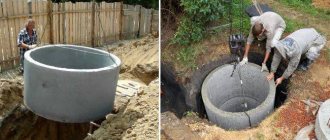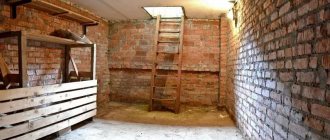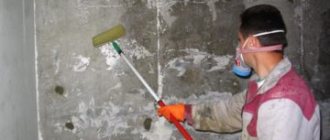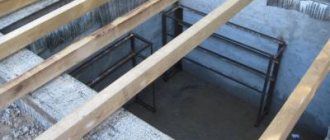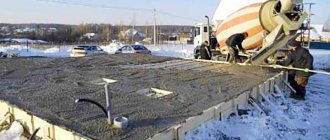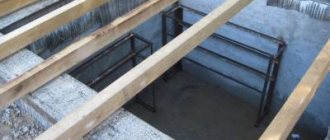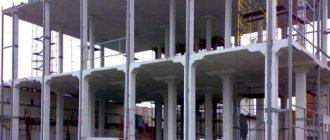Beton-House.com
Website about concrete: construction, characteristics, design. We combine the experience of professionals and private craftsmen in one place
A place for storing home preserves with constant humidity and temperature
Today we will learn how to build a concrete cellar with our own hands. The topic is very interesting and will be useful to many owners of private households - especially those who cannot imagine life without pickles.
We will also find out how long it will take to build such a structure, plus we will tell you how to properly use the energy of the soil to achieve a constant temperature inside.
- Cellar base
Advantages of a monolithic concrete cellar
The main advantage of a ready-made monolithic cellar, manufactured in a special production facility, is its complete readiness for use immediately after purchase. Cellars also have a lot of other advantages:
- Effective protection of objects inside from environmental influences. Strong concrete walls can withstand heavy loads, and additional waterproofing does not allow groundwater and other moisture to penetrate into the room. Thanks to this, you don’t have to worry about things left in a monolithic cellar, manufactured in compliance with all requirements and standards.
- Versatility and ability to be used in any location. It is noteworthy that ready-made concrete cellars can be installed in both rural and urban areas.
- Long service life and high reliability. Monolithic structures do not require additional strengthening and fixation; they themselves are characterized by high strength and resistance to heavy loads. Concrete walls are massive and durable, and are not subject to deformation. Monolithic basements come with a long warranty, so you don't have to worry about anything.
- Resistance to corrosion and rotting. Concrete itself is highly resistant to bacteria, corrosion and other destructive factors. Additional protection is provided by waterproofing, which is made from polyurea. It has a lot of advantages, which will be discussed in more detail below.
- Safety for nature and environmental friendliness. You can store food inside a concrete monolithic cellar and not worry about it becoming hazardous to health. The materials from which the cellars are made do not contain harmful inclusions and do not emit dangerous fumes. In addition, concrete cellars do not have any negative impact on the surrounding soil.
Harvest preservation all year round
To preserve the harvest during the long winter, our ancestors dug a hole, covered it with logs, straw, earth and turf to maintain a constant temperature inside.
Even earlier, when there were no refrigerators, glaciers were made. This is when large blocks of ice were left in the dug cellar, which were supposed to maintain a certain temperature for storing dried meat, pickles and barrels of sauerkraut.
It’s good that those times are irrevocably a thing of the past and now, in order to preserve fresh potatoes, onions and cabbage, you don’t need to transport ice from the river and you don’t need to annually repair the cellar roof washed away by melting snow. Now we have CONCRETE CELLARS VOLZHANIN .
Work days
Beginning of development of the RBU territory
Bioseptic Volzhanin 4 assembled
Delivery of concrete from RBU
Loading cellar Volzhanin 2
Our videos
More videos on our Youtube channel
Moisture meter and thermometer as a gift!
| Prices for cast concrete cellars: | |
| 2000 x 2000 x 2000 | Cellar cost: 95,000 rub. Shelves on a metal frame RUR 5,000 |
| Installation: 80,000 rub. — Development of the pit — Installation and leveling of the cellar - backfilling Installation is carried out using heavy equipment | |
| Cellar waterproofing with polyurea: 30,000 rub. | |
| Insulation of the cellar with polyurethane foam: 25,000 rub. | |
| 2000 x 3000 x 2100 | Cost of the cellar: 150,000 rubles. Shelves on a metal frame 8,000 rub. |
| Installation: 120,000 rub. — Development of the pit — Installation and leveling of the cellar - backfilling Installation is carried out using heavy equipment | |
| Cellar waterproofing with polyurea: 40,000 rub. | |
| Insulation of the cellar with polyurethane foam: 35,000 rub. | |
Cellar insulation with polyurethane foam HERE
Ring selection
These products do not differ in shape. If we talk about diameter, then 2 meters is the best option. If you choose smaller rings, the operation of the cellar will be complicated (it will be impossible to turn around in it, it will be impossible to properly stack food). Too large rings will complicate the installation process.
There are also minor differences in the type of ring fixation. Based on this product there are:
- With special protrusions located in the upper part of the end. Thanks to the concrete collar, it becomes possible to quickly join two rings. This is a secure locking connection. This is especially true if the cellar is installed vertically rather than horizontally. In this case, displacement of elements is eliminated.
- With standard flat ends. In this case, additional steel brackets and concrete mortar will be required for fixation. If the fasteners are reliable, then the structure itself will not move.
Healthy! Even if you use interlocking structures, you can apply a small amount of cement mixture to the fixing elements themselves.
The first type is preferable, but the second option is also quite easy to install.
The height of the rings may vary. For example, you can find products that do not exceed 40 cm or, on the contrary, meter-long reinforced concrete structures. In this case, the choice will depend on how you will install the products. If you do it manually, it's easier to work with shorter elements. But in this case there will be many more joints that will have to be sealed.
It is also worth considering several available ways to arrange a cellar from rings.
The procedure for installing a monolithic cellar
In practice, there are no problems with installing a turnkey concrete cellar. There is no need to waste time on building the foundation, floor, walls and ceilings - everything is already manufactured at the factory and cast into a monolithic structure. Thanks to this, the process of installing an underground structure is reduced to two simple steps:
- Excavation. At this stage, using special equipment, a pit of the required dimensions is dug in the ground, in which a monolithic structure will subsequently be placed.
- Installation work. Due to its heavy weight, a monolithic cellar is immersed in a dug pit using lifting equipment. After this, the pit is filled with earth and compacted well.
It takes no more than one working day from the manufacturer to install a monolithic concrete cellar. This means that you can use the basement for storing supplies and things right on the day the installation is completed.
It is recommended to entrust the installation of the finished structure to experienced installers. Only in this case can you be sure that the concrete cellar will be installed in compliance with all requirements and standards.
Horizontal (not recessed)
There is another cellar made of concrete rings - horizontal type. This is a shallow or above ground cellar. This design is suitable if the groundwater is very high. Dig a shallow pit (at least 50 cm deep, but it can be deeper - as conditions allow).
How to make a cellar from concrete rings
A foundation slab is made in the pit (10 cm thick and 20-30 cm larger in size than the dimensions of the future basement). 10-15 cm of crushed stone is poured onto the compacted bend. Pour in layers, 5 cm at a time, each layer is thoroughly compacted. Then pour and compact about 10 cm of sand. A film is spread over it, formwork is placed, and a reinforcing frame is placed in it (one belt of 10 mm reinforcement with a step of 20 cm). Under the rings laid on their sides (make a mock-up of the lower part from plywood and boards and use it as formwork). When the concrete has set, you can roll the rings into place.
The rear ring can have a bottom - then there is no need to invent a rear wall. If the ring has no bottom, the wall is covered with bricks (one and a half bricks), not forgetting to remove the exhaust pipe for ventilation. Then the supply hole is made in the opposite wall near the door.
By connecting the fragments using construction staples and sealing the joints with mortar, you get an almost finished cellar. The laid rings are covered with soil, forming a hill.
Above ground bulk cellar made of concrete rings
Now all that remains is to install the doors and fill the remaining gaps. Place metal corners or impregnated (treated) wooden beams to which the doors are attached. It is most convenient to fill the remaining gaps with bricks or backfill (with natural stone and mortar). The front wall either must be insulated from the inside, or it must be made thick - this is the only wall facing the outside.
Waterproofing with polyurea - features
During the production process, monolithic concrete cellars are necessarily equipped with waterproofing made from polyurea. This is a monolithic coating in the form of a thick and extremely elastic film that is sprayed onto the concrete surface. There are many advantages of such waterproofing, and here are just some of them:
- High elasticity and strength. Polyurea has high tensile strength - it is around 38.5 MPa. This means that even strong water pressure will not be able to break through such waterproofing, not to mention low-moving groundwater. A cellar with such insulation is reliably protected from moisture.
- Excellent wear resistance. In this parameter, urea waterproofing quite confidently outperforms not only a lot of other polymer materials, but even ceramic floor tiles.
- Highly environmentally friendly and safe for the environment. These properties are achieved due to the fact that polyurea (another name for polyurea) contains no solvents. This is a solid product with 100% dry residue and fully complies with safety requirements.
- Resistance to external factors. Polyurea waterproofing is resistant to both aggressive chemical compounds and strong ultraviolet radiation.
Also, the advantages of polyurea waterproofing include long service life, a wide range of colors, fire safety and excellent adhesion to most building materials. Based on this, we can conclude that polyurea is a really good waterproofing solution for a cellar.
Interior arrangement
The internal organization of space is carried out in full accordance with the customer’s plans - how, what and where to install, place. The basis, the key to the success of a reliable storage facility lies in proper planning of the placement of shelves, racks, and cellar departments. In some cases, it is possible to install an intermediate floor (in a large vertically oriented subfield), for example, separating a warehouse for vegetables and canned goods.
There are no specific requirements for organizing places to store preparations for the winter; everything is done in an arbitrary order. You can easily find examples on our website, or use your imagination a little to get a solution that suits your specific needs.
The main requirement is that the cellar must be clean, well ventilated, spacious, so that everything that is planned to be stored and saved can fit in it.
How to choose a place to install a cellar?
When choosing a place where a monolithic concrete cellar will be installed, you need to consider the following factors:
- Ground water level. Despite the fact that turnkey monolithic cellars are equipped with excellent protection from groundwater and moisture in principle, it is still advisable to place the basement in a place where groundwater is located as deep as possible. In this case, there will be no problems with the operation of the basement.
- Distance from home. It is recommended to place the cellar at a short distance from the house, so that even in winter you can quickly get into it without freezing. At the same time, you should not dig a pit for a monolithic cellar directly under the foundation - this can cause great harm to it.
It is also advisable, if possible, to place a monolithic concrete cellar on a small hill. This will protect the structure from moisture from the soil. On the contrary, installing a basement in a low place on the plot of land can lead to flooding of the entrance to the cellar during heavy rains or active snow melting.
A turnkey monolithic concrete cellar from the manufacturer is the best option for those who want to have their own excellent place to store supplies, tools, equipment and other things. It is impossible not to note the completely adequate cost of monolithic solutions, which certainly will not exceed the cost of money and time to build a cellar with your own hands. Think about purchasing a ready-made concrete cellar at an affordable price now.
Ventilation
In order for supplies to be well stored, ventilation must be organized in the cellar. With active air movement, the humidity inside is naturally regulated. There are two ways to organize ventilation in the cellar:
- With two pipes located at different heights - supply and exhaust.
- With one pipe - supply and exhaust.
Methods of cellar ventilation
In order for ventilation to function normally, two pipes are needed - supply and exhaust. They are placed in opposite corners of the room, positioned diagonally. The supply pipe starts at a distance of 40-50 cm from the cellar floor. It can be brought out through the wall or up to the level of the roof (cover). The exhaust pipe should remove as much exhaust air as possible, so it starts almost at the ceiling - 10-15 cm lower. It is displayed straight up, rising at least a meter above the roof (lid). To prevent leaves from getting into the pipes, they are covered with mesh, umbrellas are put on, and a deflector can be placed on the exhaust pipe to improve draft.
How does this ventilation work? Due to the difference in temperature, pressure and wind force. The autumn-winter period is warmer in the cellar than outside. Plus, due to the fact that the exhaust pipe is raised above the roof, a pressure difference is created. These reasons cause warm air from under the ceiling to rush up through the pipe. In place of the removed part of the air, fresh air enters the cellar through the supply pipe. This process occurs constantly at varying speeds. Sometimes in winter it is too active, and you have to reduce the cross-section of the ventilation pipes. To do this, you can install a damper like a damper or a stove view, but usually they do it simpler - they close the pipe from above with some kind of plate, partially blocking its lumen.
In small cellars located on a hill, you can get by with one pipe. In this case, the air is alternately drawn out and then supplied.
